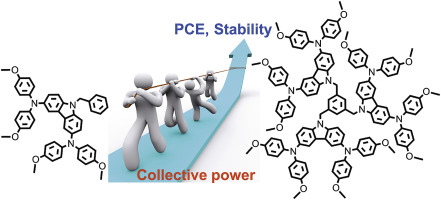Organic Electronics ( IF 2.7 ) Pub Date : 2018-05-24 , DOI: 10.1016/j.orgel.2018.05.024 Thanh-Tuân Bui , Maria Ulfa , Federica Maschietto , Alistar Ottochian , Mai-Phuong Nghiêm , Ilaria Ciofini , Fabrice Goubard , Thierry Pauporté

|
Designing organic molecules efficient for charge extraction and transport when integrated in optoelectronic devices remains a great challenge for many advanced applications. In perovskite solar cells (PSCs), the hole extraction/transport and the device stability are strongly dependent on the molecular structure of the hole transporting material (HTM). Herein we have engineered a dendritic core carbazole based HTM (named B186), which combines the advantages of both small molecules and polymeric materials. The material can be easily prepared in a short synthetic procedure from largely available commercial products. We have investigated in-depth the relationship between the chemical structure of the HTM and both the photovoltaic efficiency and the device stability. It has been shown that the dendritic core is a promising approach leading to both enhanced device performance and stability. The new HTM has been proved to act as a good barrier and protect satisfactorily the perovskite surface. The power conversion efficiencies (PCE) increase from 11.5% for the simple model compound to a promising 14.6%. Additionally, the normalized PCE of B186-based PSC decreased by only 5% after more than three weeks of storage under ambient conditions meanwhile the cell using the most popular HTM (Spiro-OMeTAD) dropped off by more than 40%. The presented results demonstrate that introducing dendritic concept is a simple strategy to design HTM for efficient and stable PSC.
中文翻译:

用于高效,稳定的混合钙钛矿太阳能电池的树枝状核咔唑基空穴传输材料的设计
当集成到光电设备中时,设计有效用于电荷提取和传输的有机分子仍然是许多高级应用程序面临的巨大挑战。在钙钛矿太阳能电池(PSC)中,空穴的提取/传输和器件稳定性在很大程度上取决于空穴传输材料(HTM)的分子结构。本文中,我们设计了基于树突核咔唑的HTM(命名为B186)),结合了小分子和聚合材料的优点。该材料可以通过很短的合成程序轻松地从大量可商购的产品中制备。我们已经深入研究了HTM的化学结构与光伏效率和器件稳定性之间的关系。已经表明,树枝状核是一种有前途的方法,可以提高器件的性能和稳定性。事实证明,新的HTM可以作为良好的屏障,并令人满意地保护钙钛矿表面。功率转换效率(PCE)从简单模型化合物的11.5%提高到了有希望的14.6%。此外,B186的标准化PCE在环境条件下储存三周以上后,基于PSC的PSC仅下降了5%,而使用最受欢迎的HTM(Spiro-OMeTAD)的电池下降了40%以上。提出的结果表明,引入树突状概念是设计用于高效且稳定的PSC的HTM的简单策略。









































 京公网安备 11010802027423号
京公网安备 11010802027423号